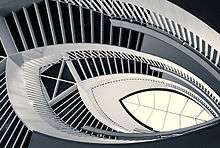Josef Paul Kleihues
Josef Paul Kleihues (11 June 1933, Rheine – 13 August 2004, Berlin) was a German architect, most notable for his decades long contributions to the "critical reconstruction" of Berlin. His design approach has been described as "poetic rationalist".[1]
Early life and career

Born in 1933 in Rheine, he studied architecture at the University of Stuttgart (1955–57) and Berlin Institute of Technology (1957–59). After graduation, he spent one year at the École nationale supérieure des Beaux-Arts in Paris. After having worked in the architectural practice of Peter Poelzig in West Berlin, in 1962 he founded his own practice with Hans Heinrich Moldenschardt.[1]
In 1971 he designed "Block 270", a residential building in Berlin-Wedding. This became a seminal work which re-established the Berlin block plan, a traditional typology, which stood in opposition to contemporary urban planning. As professor at the Dortmund University of Technology from 1973[1] and director of the International Building Exhibition Berlin (IBA) between 1979-1987, Kleihues propagated the concept of urban "critical reconstruction".[2]
Kleihues received international recognition for several museum projects, including for the Sprengel Museum in Hanover (1972) and the Museum of Prehistory in Frankfurt (1980–86). He continued designing museums, including the Civic Gallery and Lütze Museum in Sindelfingen (1987–90), the Berlin Museum of Contemporary Art, an adaptive reuse of the Hamburger Bahnhof, a 19th-century railway station, and the Museum of Contemporary Art, Chicago.[1]
References
- 1 2 3 4 Childs, David: Professor Josef Paul Kleihues, obituary in The Independent, 10 September 2004
- ↑ Dawson, Layla: Josef Paul Kleihues 1933-2004 in The Architectural Review, December 2004
External links
![]() Media related to Josef Paul Kleihues at Wikimedia Commons
Media related to Josef Paul Kleihues at Wikimedia Commons